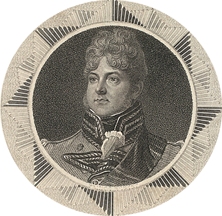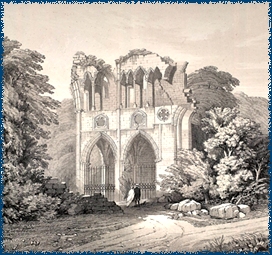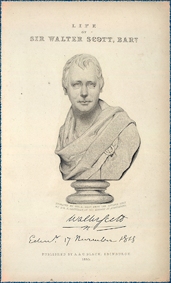|
|

|
|
|
Home | Corson
Collection | Biography | Works | Image
Collection | Recent Publications | Portraits | Correspondence | Forthcoming
Events | Links | E-Texts | Contact
Chronology
Early Years
- 1771 - Scott is born in Edinburgh on 15 August, the ninth child
(fourth surviving) of Walter Scott,
Writer to the Signet, and Anne Rutherford.
- 1773 - Contracts polio which renders him lame in his right leg
for the rest of his life. Sent to live with his grandfather Robert
Scott at Sandyknowe in the Borders.
- 1775 - Briefly returns to Edinburgh following his grandfather's
death but is sent to Bath in the summer to attempt a water cure.
Visits London.
- 1776 - Returns from Bath in the summer and is sent back to Sandyknowe.
- 1778 - Returns to Edinburgh to live at his father's new house
at 25 George Square.
- 1779 - Enters the High School of Edinburgh.
- 1783 - Leaves school and goes to Kelso
to stay with his Aunt Janet (Jenny) Scott for a year. At Kelso
Grammar School, meets his future friend and business partner,
James Ballantyne.
- 1783-86 - Attends Edinburgh University.
- 1784-85 - Health deteriorates again and has to interrupt his
studies. All treatments fail and is sent back to Kelso to live
with his aunt for a year.
Back to top
Professional Life
- 1786 - Apprenticed to his father's legal firm, but soon decides
to aim for the Bar.
- 1786-87 - Visits the Highlands on business where he meets a
client of his father, Alexander Stewart of Invernahyle, who had
once fought a duel with Rob Roy MacGregor. Scott, only fifteen
years of age, also meets Robert Burns. This remains the only meeting
of the two great Scottish writers.
- 1789-92 - Resumes his studies and reads law at Edinburgh University.
- 1790 - Meets and falls in love with Williamina
Belsches.
- 1792 - Qualifies as a lawyer and is admitted to the Faculty
of Advocates.
- 1792-6 - Practises as an Advocate in Edinburgh.
- 1797 - Heartbroken when spurned by Williamina who marries William
Forbes of Pitsligo. Visits the Lake District and meets Charlotte
Carpentier whom he marries on Christmas Eve in Carlisle
Cathedral. Moves to rented accomodation in George Street,
Edinburgh.
- 1798 - Rents a cottage at Lasswade
on the River Esk, where he will summer each year until 1804.
- 1799 - Scott's father dies in April. Birth of Scott's first
daughter, Charlotte Sophia, on 24 October. On 16 December, Scott
becomes Sheriff-Deputy of Selkirkshire,
an office he holds until his death in 1832.
- 1801 - Birth of Scott's first son, Walter, on 28 October. In
December, moves to 39 Castle Street which
will remain his Edinburgh home until 1826.
- 1803 - Birth of Scott's second daughter, Anne, on 2 February.
Back to top
Years of Prosperity
- 1804 - Moves with his family to Ashestiel
near Galashiels, retaining 39 Castle Street as as a winter residence.
- 1805 - Enters into a secret business partnership with James
Ballantyne. Birth of Scott's second son, Charles, on 24 December.
- 1806 - Becomes Principal Clerk to the Court
of Session in Edinburgh, permitting him a steady income from
the law without having to practise as an Advocate.
- 1809 - Becomes half-owner of John Ballantyne's
publishing company.
- 1810 - Williamina Forbes dies at the age of 34.
- 1811 - Buys Cartley (nicknamed Clarty) Hole Farm. Extends the
original four-room cottage and renames his new home Abbotsford.
Scott and his family move into Abbotsford in 1812.
- 1813 - Collapse of John Ballantyne and Co. The company's assets
are bought by Archbald Constable and Co. who remain Scott's publishers
until 1826. Scott is rescued from impending bankruptcy by his
patron, the Duke of Buccleuch (see Financial
Hardship).
- 1816 - Inherits the estate of his brother, Major John Scott
(1769-1816).
- 1818 - Heads a team which rediscovers the lost Regalia (Crown
Jewels) of Scotland in Edinburgh Castle. The Prince Regent rewards
him with a baronetcy.
- 1819 - Scott's mother dies.
- 1820 - Elected President of the Royal Society of Edinburgh.
In April, Scott's eldest daughter Sophia marries John Gibson Lockhart,
his future biographer.
- 1821 - Birth of Scott's grandson John Hugh Lockhart (the 'Hugh
Littlejohn' of Tales
of a Grandfather) on 14 February.
- 1822 - Plays a leading role in organizing the visit of King
George IV to Edinburgh. This is the first visit of a Hanoverian
monarch to Scotland.
|
|
 |
Click on the thumbnail to view full-size
image of a portrait of King George IV
|
- 1825 - In November, Scott starts to keep his 'Journal' (posthumously
published in 1890). Suffers poor health and fears financial ruin.
|
|
|
Click on the thumbnail to view the full-size image of the title
page of John Gibson Lockhart's Memoirs of the Life of Sir
Walter Scott, Bart. (2nd ed: 1839). The engraving by George
Baird Shaw shows the 1820
bust of Scott by Sir
Francis Leggatt Chantrey.
|
The Years of Decline
- 1826 - Becomes insolvent after the failure of his publishers,
Archibald Constable, and his printers, James Ballantyne (see Financial
Hardship). Pledges the future income from his publications
to a trust in order to repay his creditors. The start of an excessive
period of work, which is to affect his health. On 15 May, Scott's
wife dies.
- 1827 - Finally admits to the authorship of the Waverley novels
at a public dinner.
- 1828 - Makes preparations for a complete annotated edition of
his works, later nicknamed the Magnum Opus.
- 1829 - Suffers from haemorrhages.
- 1830 - Declines the offer of a Civil List pension and the rank
of Privy Councillor.
- 1831 - Suffers a stroke and then apoplectic paralysis. Goes
to Italy with his daughter Anne to recuperate. On 15 December
receives news of the death of his ten year old grandson John Hugh
Lockhart.
- 1832 - Returns from the continent. Dies at Abbotsford on 21
September and is buried beside his wife in Dryburgh Abbey.
|
 |
Click on the thumbnail to view the full-size image of a lithograph
of Dryburgh Abbey.
|
|
Back to top
The Poet
- 1782 - Writes his earliest verse.
- 1796 - Publishes The Chase, and William and Helen, translations
of two poems by Gottfried August Bürger.
- 1797 - Translates dramas from the German of Maier, Iffland,
Schiller, and Von Babo, and ballads and drama by Goethe.
- 1799 - Publishes a translation of Goethe's drama Goetz von
Berlichingen. The Ballantyne Press privately prints Scott's
ballad 'The Eve of St John' and An Apology for Tales of Terror,
containing three of Scott's translations from German.
- 1800 - Collects, edits and reworks material for a ballad collection
called the Minstrelsy
of the Scottish Border to be published by Ballantyne.
Matthew Gregory Lewis's anthology Tales of Wonder contains
three original ballads by Scott.
- 1802 - First edition of the Minstrelsy.
- 1803 - An expanded 3 volume edition of the Minstrelsy
is published.
- 1804 - Scott's edition of the medieval romance Sir Tristrem with a conclusion furnished by himself.
- 1805 - The Lay of
the Last Minstrel is published to critical and popular
acclaim.
- 1807 - The Edinburgh Publisher Archibald Constable pays Scott
1,000 guineas for a poem he had not yet written: Marmion
went on to sell 28,000 copies by 1811. Completes Joseph Strutt's
historical romance Queenhoo Hall.
- 1809 - Involved in the foundation of the Quarterly, a
Tory rival to the Edinburgh Review.
- 1810 - The Lady of the
Lake is published and proves even more popular than Marmion,
selling 25,000 copies in eight months.
- 1811 - Publishes The
Vision of Don Roderick.
- 1812 - Has a new poetic rival in Lord Byron, whom he meets in
1813.
- 1813 - Rokeby
and The Bridal of
Triermain are published. Is offered and declines the Poet
Laureateship.
Back to top
The Novelist
- 1814 - First novel Waverley
published anonymously. Becomes the most successful novel ever
published in English.
- 1815 - Publishes second novel Guy
Mannering and The
Lord of the Isles, his last major poetic work. During
a trip to Waterloo and Paris, writes The
Field of Waterloo.
- 1816 - The Antiquary
and the first series of Tales of My Landlord are published,
consisting of Old
Mortality and The
Black Dwarf. Also publishes Paul's
Letters to His Kinsfolk, imaginary letters describing
his travels in Belgium and France.
- 1817 - Writes Rob Roy
and publishes Harold
the Dauntless, his last long poem.
- 1818 - The Second Series of Tales of My Landlord (The
Heart of Midlothian) is published. Writes 'Essay on Chivalry'
for the Encylopaedia Britannica.
- 1819 - Suffering from gallstones, dictates
A Legend of Montrose and The
Bride of Lammermoor
which are later published as Tales of My Landlord,
Third Series. Also dictates
Ivanhoe which is published at the end of the year and
is enormously successful, selling 10,000 copies in a fortnight.
- 1820 - The Monastery
and The Abbot
are published.
- 1821 - Kenilworth
and The Pirate
are published.
- 1822 - The Fortunes of Nigel is published.
- 1823 - Peveril of
the Peak, Quentin
Durward and St.
Ronan's Well are published.
- 1824 - Redgauntlet
is published.
- 1825 - Tales of the Crusaders, The
Betrothed and The
Talisman are published.
- 1826 - Leads a successful campaign through The
Letters of Malachi Malagrowther to preserve the Scottish
banknote. Publication of Woodstock.
- 1827 - The Life of
Napoleon and Chronicles
of the Canongate are published.
- 1828 - The Fair Maid
of Perth and the First Series of Tales
of a Grandfather are published.
- 1829 - Anne of
Geierstein and the Second Series of Tales of a Grandfather
are published.
- 1830 - Writes, at J.G. Lockhart's suggestion, the Letters
on Demonology and Witchcraft. Third Series of Tales
of a Grandfather.
- 1831 - Fourth Series of Tales of a Grandfather and
Fourth Series of Tales of My Landlord (Count
Robert of Paris and Castle
Dangerous) are published.
Back
to top
Back to Biography Index
Last updated: 20-July-2012
© Edinburgh University Library
|
|



